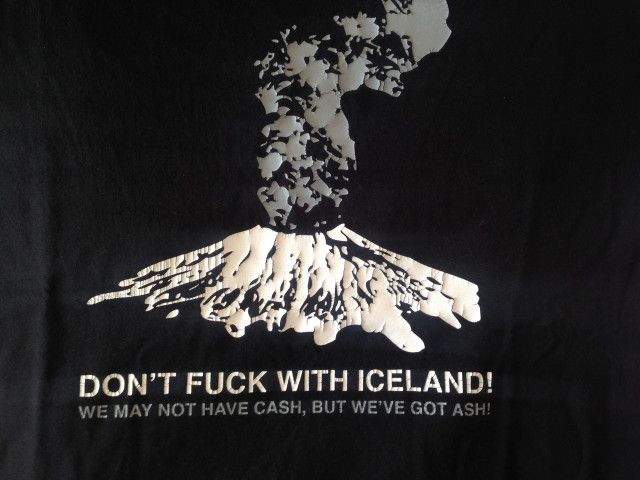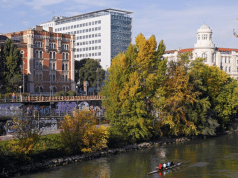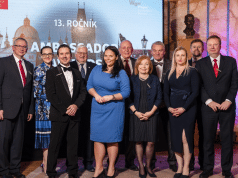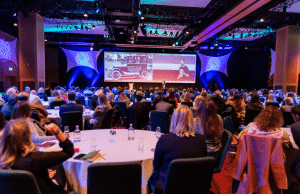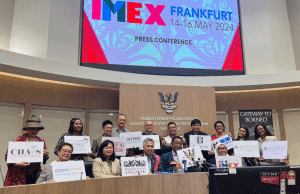Designing experiences and telling stories in tourism
As an avid traveler, I’m a sucker for cool destinations and places that inspire with their weirdness. I rarely plan much in advance, so I consider myself a tourist by chance who’s open to serendipity. So, I’m your target persona if you do innovative tourism products for impulsive buyers. Wanna sell me a detour to Delft on my way to Amsterdam? You can. But you don’t.
Why, because hospitality and tourism often lack any storytelling. Weird, right? Stories and memorable experiences should be the default priority for anyone working in tourism and hospitality. Yet, all they seem to care for is to optimize the buying process.

GIVE THEM DREAMS
Andraž Štalec from the digital marketing agency Red Orbit raised this same issue at the latest Travel Zoom conference, urging anyone working in the travel industry to re-consider their efforts in what he calls the “dreaming” state. It is the stage we, as consumers, find ourselves so often, yet as Andraž pointed out, that in tourism almost no-one cares about it. They rarely sell us stories about magical places that will reunite us with our inner selves. Or about experiences that will leave us breathless. At best, we see a pretty picture and a catchy tagline without any meaning, or, god forbid, story behind.
The IT industry seems to care more about the dreaming state we find ourselves before buying shiny objects like computers. Apple is the king of experience marketing. And they, for sure, don’t sell computers and mobile phones. No, no, they sell dreams, they sell empowerment and enrichment. Apple is selling us their story! And we’re gladly buying it, over and over again.
DREAMS ARE STORIES
What Apple sells are nothing more than stories. Same with all the powerful brands you try to hate, but keep returning back to. You trust the German car manufacturers because of stories, you go for a coffee at that small barista because of stories. It’s the same when you travel, but it is often your personal experiences, your stories that guide your decisions. Of course, you’re influenced by well-designed leaflets or cool Facebook campaigns. But most importantly, you’re motivated by the price. And the tourism industry knows this and, therefore, bombards you with “special offers.“
After you click on the banner saying “Sicily in your pocket for €450” you land on a website that looks the same as all the others. Generic photos rotating in the header and a big red “Book” button. Where’s the mobsters story? Or the story about a nun making the best homemade pasta in the world? There are exceptions, but too often you see same, generic photos and cheesy punchlines.
When the organisers asked me to have a talk and a workshop at the Travel Zoom conference, it was a no-brainer. I could finally share my frustration with the relevant stakeholders. As a UX guy, I could rant about their boring and too sales-y websites and their overly crowded interfaces. Instead, I decided to try and help them understand why at all should they care about offering pleasurable experiences. And try to shed some light on how to tell better product stories.
STORIES ARE EXPERIENCES
When you travel, for work or pleasure, it’s about the experience. Traveling is an adventure: packing the essentials, waiting for the flight, excitement before takeoff, fear before landing, losing your luggage… You know the drill.
You always come home with stories. About the clumsy bellboy at the official conference hotel, about the camel herder you met on the family trip to Tunisia. Marketers in tourism should be more aware of this and create environments open for stories. Open for serendipity, where tourists co-create memorable experiences that last in the form of epic stories.
But what makes a good story? Here are six elements I think are key to every good story nowadays. A good story is: honest, authentic, consistent, quirky, responsive and personal.
THE STORY OF ICELAND
One of my favorite destinations ever is Iceland. The island is nothing less than magical. Its people are crazily creative, the landscape is breathtaking and the whole experience of Iceland is… a story to remember.
On the other hand, Iceland is a country that almost went bankrupt in 2010, plus it’s a country with regular volcano eruptions. So, you would think they spend millions to cover this up and promote the island as a peaceful destination for rich tourists. Right? Wrong.
Let’s see how they use the six elements to create memorable experiences.
HONEST
I believe honesty is the cheapest and most successful method ever. As weird as it sounds (right, ladies?) it always works. Well, almost. Especially if you create a lovely story around it.
Let’s see how Iceland reacted after the volcano eruption that grounded half of the airplanes in the world for weeks. They were honest about it. So what if you have regular volcano eruptions. So what if you are broke. There is no point in hiding something that is obvious. People are not stupid, so stop faking and pretending that you are something that you are not.
We, as human beings, often think bad of ourselves and hence find shelter in pretending. Apply this to brands and you get companies spending millions to re-invent themselves, to resemble the big players. This is even truer in tourism where destinations try to be something they are not. Imagine Iceland trying to promote themselves as the top destination for hordes of middle age Europeans searching for their yearly dose of beer and sun.
AUTHENTIC
Instead, Iceland tries to find their true self, their uniqueness. Being honest is one of the things that makes Iceland authentic. Some would say, they have an easy job, as they are a truly unique destination because of the geysers and volcanos. But this is not what makes them truly authentic. These are simple artifacts.
What makes them authentic is the attitude of its people, the whole Iceland experience. Which is much more than geographical phenomena. Iceland is embracing its history, its mythology and the roots. They are proud of it and share it with the tourists. For example, there are numerous people traveling to Iceland to experience the old Norse religion that has been revived in Iceland.
Being authentic should be the core of every good story, every experience. This is what makes you unique. It’s what I call the Hat. The hat makes the difference and it pays out if you invest heavily in finding yours. This does not mean inventing something new, your authenticity often lies hidden in the stories, in history.
For example, I come from Slovenia, the only chicken-shaped country. It is also the only country with the word “love” in its name. But which one do you think has more story potential? Well, I strongly disagree it’s the latter, but sadly the officials disagree with me.
CONSISTENT
Once you find what makes you stand out, what’s special and truly authentic about you, you should stick to it. Consistency is extremely important in crafting powerful stories. You must master transmedia storytelling and have your message flow from the tagline on your website to the “thank you” note in your hotel room.
When we work on stories at Edgar we always design the story world first. This is the world with a clear user journey, where the rest is open for the users to experience in their own way. As a user experience designer, I follow the same principle: you can not design the whole experience, but you can think about all the possible outcomes and design a place for joyful interactions to happen.
Again, Iceland does a great job here, from the moment you step on an Air Iceland plane to when you interact with their official Twitter account. It’s the same quirky personality that is Iceland.
QUIRKY
Quirkiness is what makes Iceland really unique, authentic, and it is their quirky tone that follows you the whole time. It’s a bold move, to be known as the weird, quirky country. But it worked extremely well for Iceland.
We love to be entertained, especially with smart, witty humor. It’s not easy to be funny if you are in the tourism or the hospitality business. But you should try it. And don’t forget, you don’t have to be super fun in the old fashioned way. Pretending to be fun can always backfire, so please be careful. If you don’t have it in you, there’s no point in pretending. Instead, just be original, relaxed and have a bit different tone of voice than the rest.
RESPONSIVE
Another element of a good product story is responsiveness. No matter in what industry you are, you can’t afford to be slow and ignorant. If you run a hotel in a place that suddenly became famous for the best blueberry pies in the world… well, hop on the train and have your say about it.
Also, if your customers are taking funny selfies with your weird hotel logo and post them on Instagram… join the hype and make fun of yourself. My point is, your story needs to be close to your customers and has to be where they are.
Iceland is again a great example here. They use Tumblr for fast and responsive blogging and they use Twitter for speedy interactions. Both use the same quirky tone of voice that is also quickly adopted by others.
Another great example of a good responsive campaign comes from Croatia. They found out that coaches of both teams in the SuperBowl Finals (American Football) have Croatian origins. They decided to invite them for a vacation to Croatia to help them discover their roots. But this is not the end of it, they went on Twitter with the hashtag #SuperBowlCroatia and invited everyone to participate. The response was amazing for the Croatian National Tourist Organisation and Croatia in general.
PERSONAL - THE WHY
Finally, the most important thing is your own Why. As Simon Sinek said: the Why powers the most successful brands. Why does your company exist? What is the story behind? What is the story of the place you’re promoting? Get personal with it. We all love to hear a story that feels honest and personal. Tell the story behind your employees or the story of the hotel owner. Or even better, tell stories about the little people at your destination. Make them heroes of your story.
If you do that, people will relate. And when customers relate, when they feel emotionally connected, then you have fans for life instead of happy customers.
THE END
These are the six elements I believe make a good product story. They work extremely well when applied to tourism products and designing pleasant, memorable experiences. And this is what traveling is all about, right? Creating memories that transcend into stories.
DAMJAN OBAL
Damjan Obal is UX guy with a PhD, storyteller and hobby magician. Love magical places where design, technology and stories meet. Launched a couple of products and 2 startups. Last one is Edgar – the startup that brings the power of brand storytelling to SMBs.
[xyz-ihs snippet=”KONGRES-SUMMET-ISSUE”]


